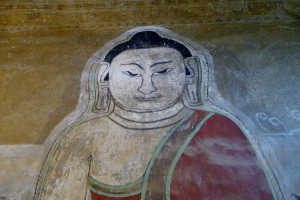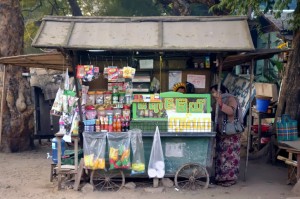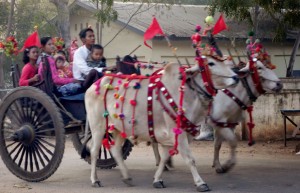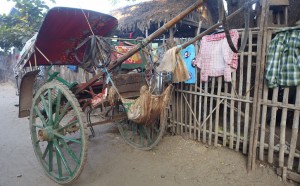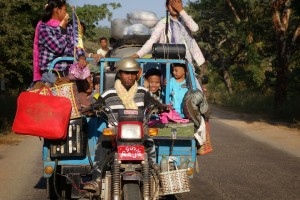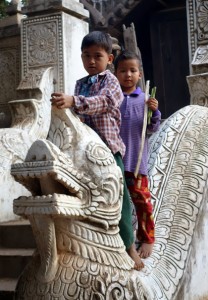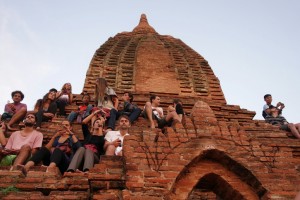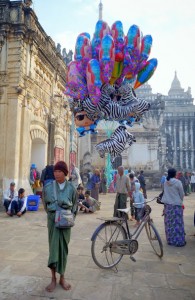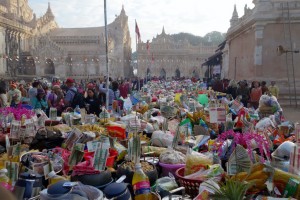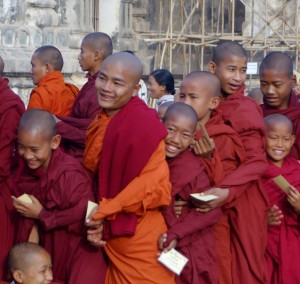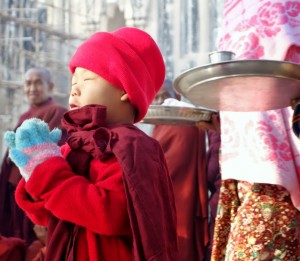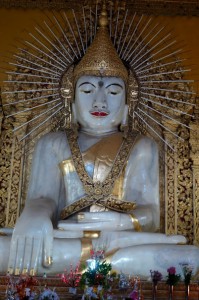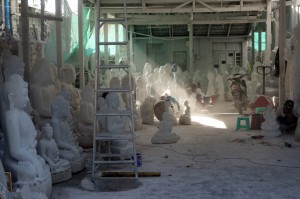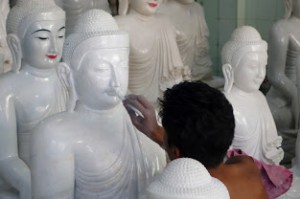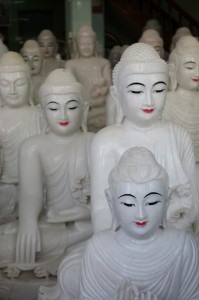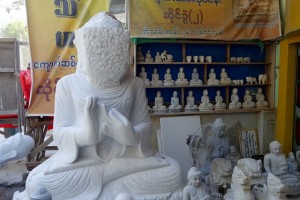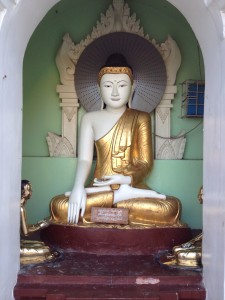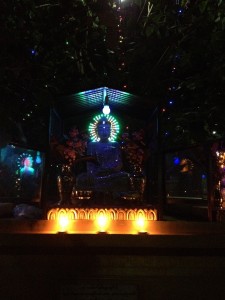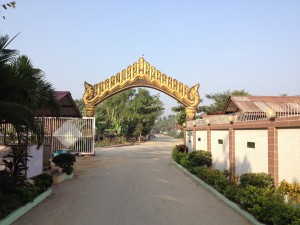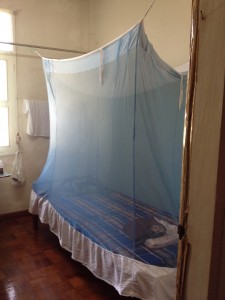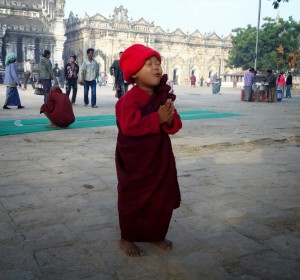Mindful Reading
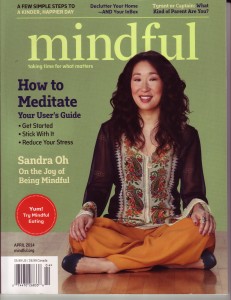 My teacher, Mirabai Bush, has an article in the April issue of the new Mindful magazine. She writes about Mindful Reading, Mindful Writing (including Mindful Emailing), Mindful Listening and more. Here’s a sample:
My teacher, Mirabai Bush, has an article in the April issue of the new Mindful magazine. She writes about Mindful Reading, Mindful Writing (including Mindful Emailing), Mindful Listening and more. Here’s a sample:
Mindful reading is radically different. It slows down the reader and the reading–that alone changes the experience. It is a process of quiet reflection that requires mindful attentiveness, letting go of distracting thoughts and opinions to be fully in the moment with the text. It moves the reader into a calm awareness, allowing for a more powerful experience and understanding…
Savoring a Resonant Phrase
Sit quietly, and then read a short piece, perhaps a page long. What phrase stands out for you? Return to that phrase and repeat it to yourself, perhaps several times. Just sit with it. What does it evoke? Notice what images or ideas or memories arise. Do any of the words have meaning beyond the obvious? What meaning does this phrase give to the rest of what you’re reading? Hold the phrase in your mind, giving it time to suggest more to you. Now re-read the full piece. How is it different? Has your relationship to it changed?
***
Want to read more (mindfully)? Click here.
One Last Look
I feel like I could keep posting forever about the trip to Burma, but we’re into March now and I’m thinking it’s time to move on. Still, there are lots more photos I’d like to share (many shot by fellow traveler Jacob Art), so I’ll post one last batch, in no particular order, and with that…I will bid Burma a fond farewell.
Questions, Answers and Cities
Maybe it’s because Burma seemed so other-worldly to me, but I keep thinking of the trip in terms of that magical book by Italo Calvino, Invisible Cities. This passage, for example, keeps running through my head:
 …With cities, it is as with dreams: everything imaginable can be dreamed, but even the most unexpected dream is a rebus that conceals a desire or, its reverse, a fear.
…With cities, it is as with dreams: everything imaginable can be dreamed, but even the most unexpected dream is a rebus that conceals a desire or, its reverse, a fear.
Cities, like dreams, are made of desires and fears, even if the thread of their discourse is secret, their rules are absurd, their perspective deceitful, and everything conceals something else.
“I have neither desires nor fears,” the Khan declared, “and my dreams are composed either by my mind or by chance.”
Cities also believe they are the work of the mind or of chance, but neither the one nor the other suffices to hold up their walls. You take delight not in a city’s seven or seventy wonders, but in the answer it gives to a question of yours.
Or to the question it asks, forcing you to answer, like Thebes through the mouth of the Sphinx.
***
photo taken on the road up to Mandalay Hill
Buddha Bling
My favorite thing that I brought back from Burma was what I call my “Disco Buddha.”
OK, this is going to take a little explaining. First let me say that one of the most distinctive things about the Burmese style of Buddha statues was that many, many, many of them have a “halo” of flashing, multi-colored LED lights radiating from his head! This is because tradition holds that when the Buddha was enlightened, he emanated great rays of light.
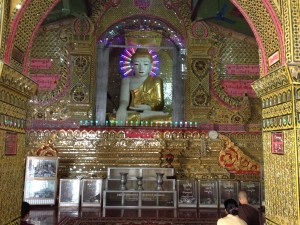 You can see a bit of it here, around the Buddha’s head in one of the alcoves on the top of Mandalay Hill.
You can see a bit of it here, around the Buddha’s head in one of the alcoves on the top of Mandalay Hill.
 You can see more of it here, in this photo of our group taken in one of the pavilions at the Shwedagon Pagoda in Yangon.
You can see more of it here, in this photo of our group taken in one of the pavilions at the Shwedagon Pagoda in Yangon.
And at the monastery, which didn’t have any Buddhas at all in the meditation hall, there was a Bodhi tree in the garden with Buddha statues in little shrines all around it. During the day, it looked quite sedate, but at night….wowzah…it was lit up like Las Vegas!
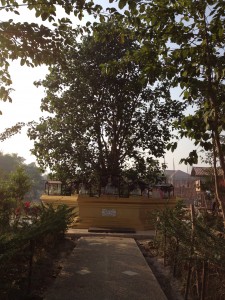 Here’s the tree in the daytime.
Here’s the tree in the daytime.
 And here is one of the shrines, also during the day.
And here is one of the shrines, also during the day.
So when I was walking down the steps from the Shwedagon Pagoda one evening and saw a little glass Buddha that lit up with flashing colors (which came from LED lights in the cheap plastic platform he was sitting on), I just had to have him.
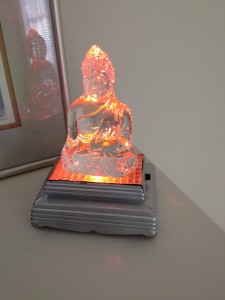
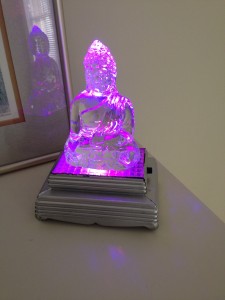 Here he is. It doesn’t come across very well in photos, but he changes colors constantly…and somewhat erratically…from blue to orange to pink to a deeper blue to yellow to a combination of white-and-blue to purple to bright red, etc etc etc.
Here he is. It doesn’t come across very well in photos, but he changes colors constantly…and somewhat erratically…from blue to orange to pink to a deeper blue to yellow to a combination of white-and-blue to purple to bright red, etc etc etc.
 And here he is at night, in his golden-orange incarnation.
And here he is at night, in his golden-orange incarnation.
I know it’s crazy, but I just love turning him on and listening to Pa Auk Sayadaw chanting the Pali blessing chants in the Burmese style I heard the monks chanting, early in the morning, at the monastery, which you can listen to here.
It makes me feel like I’m back “home” in Burma! (But in a comfortable bed.)
What I Brought Back
The experience of just being there was the most precious thing I brought back with me from Burma, but of course, I wanted to bring something physical back home with me too. Not exactly to hold onto the experience….but to help me remember and reflect on it.
 Here’s what I wanted to bring home.
Here’s what I wanted to bring home.
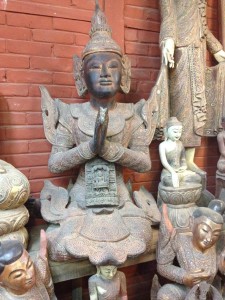 And this, too. But of course I have nowhere to put either of these. I didn’t even ask how much they cost…or what it would have take to have them shipped home!
And this, too. But of course I have nowhere to put either of these. I didn’t even ask how much they cost…or what it would have take to have them shipped home!
 Instead, I opted for this little beauty. (Which I could slip into my carry-on bag.) I love the sweet smile. And the somewhat androgynous features of his/her face.
Instead, I opted for this little beauty. (Which I could slip into my carry-on bag.) I love the sweet smile. And the somewhat androgynous features of his/her face.
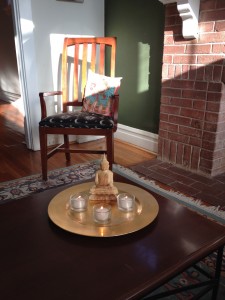 Here s/he is on the coffee table in my living room, with candles lit for the Buddha, the Dhamma and the Sangha.
Here s/he is on the coffee table in my living room, with candles lit for the Buddha, the Dhamma and the Sangha.
 And here’s the whole room. Might be a nice place for a sit, don’t you think?
And here’s the whole room. Might be a nice place for a sit, don’t you think?
I brought a few other things back with me, too. More on that tomorrow.
What Does a Monastery Look Like?
Here are some photos I took at the Shwe Oo Min monastery. It didn’t look like I thought a monastery would look. I imagined a big fancy temple with hushed corridors leading to modest-but-comfortable single rooms for us to stay in. Instead it was more like a small town with a main street of fancy “houses” and long covered walkways leading to various other, fairly non-monastic-looking buildings including several dorms, a big warehouse-y mediation hall, an open-air kitchen and dining hall.
 Here’s one of the houses, called a “kuti,” where the administrative Sayadaw (head monk) lives.
Here’s one of the houses, called a “kuti,” where the administrative Sayadaw (head monk) lives.
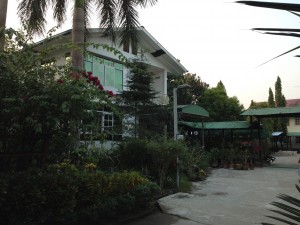 Here’s the kuti where U Tejaniya, the meditation Sayadaw, lives.
Here’s the kuti where U Tejaniya, the meditation Sayadaw, lives.
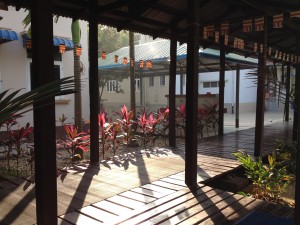 Here is a part of the covered walkways.
Here is a part of the covered walkways.
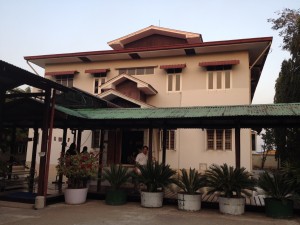 Here’s one of the dorms where some of the monks live.
Here’s one of the dorms where some of the monks live.
 Here’s another one of the dorms.
Here’s another one of the dorms.
 Here’s the dorm where I lived.
Here’s the dorm where I lived.
All the rooms are doubles. The furnishings are very basic: a bed (which is just a board on legs with a rattan mat and a three-quarter-inch foam pad), a mosquito net, a small metal folding table (which is to be shared) set between the two beds, and a wire strung between two nails in the wall behind each bed (from which one hangs one’s towel, or whatever). No drawers or shelves or anything like that. Not even any hooks. There’s a window and a curtain draped over a rod, but the curtain doesn’t cover the window. There is an overhead light –florescent–and an old-fashioned oscillating fan attached to the ceiling. No electrical outlets. No place, except the floor, to put your luggage. The toilets, sinks and showers are down the hall. There’s nothing else. That’s it.
 Here’s the front room in U Tejaniya’s kuti, where you go to ask permission to leave the monastery, if you need to, and where you can log onto the internet between 8:00 and 9:00 am –if the server is working that day. This is also where we met with him once a week, in a group, to report on our practice and ask questions.
Here’s the front room in U Tejaniya’s kuti, where you go to ask permission to leave the monastery, if you need to, and where you can log onto the internet between 8:00 and 9:00 am –if the server is working that day. This is also where we met with him once a week, in a group, to report on our practice and ask questions.
 Here we are all on the internet. One day it like this when U Tejaniya came in and sat down at his desk in the front of the room. A few people looked up, but then went right back to their iPhones. He didn’t say anything for awhile. It was absolutely silent in the room, except for the furious clicking of keyboards. Finally he said: Hmmm. Very concentrated. But not very mindful. Then he just laughed and laughed.
Here we are all on the internet. One day it like this when U Tejaniya came in and sat down at his desk in the front of the room. A few people looked up, but then went right back to their iPhones. He didn’t say anything for awhile. It was absolutely silent in the room, except for the furious clicking of keyboards. Finally he said: Hmmm. Very concentrated. But not very mindful. Then he just laughed and laughed.
Morning at the Monastery
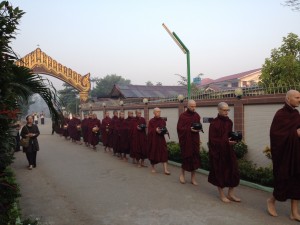
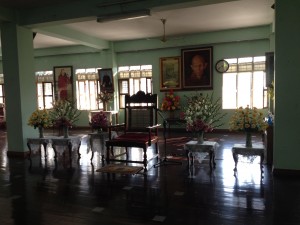

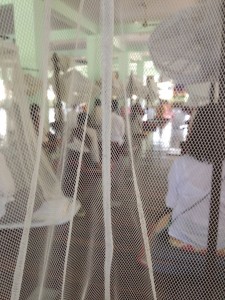 I stayed two weeks at the Shwe Oo Min Monastery, which is a little more than half of the total time I was in Burma, and in some ways it was the most exotic part of the trip — because I was actually participating in the culture, as opposed to staying at hotels, visiting sites, and passing on through. It was also the most boring part of the trip…because it was pretty much the same thing, day after day…but now that I’m back and into my “normal” home-town life, it’s what I remember most vividly.
I stayed two weeks at the Shwe Oo Min Monastery, which is a little more than half of the total time I was in Burma, and in some ways it was the most exotic part of the trip — because I was actually participating in the culture, as opposed to staying at hotels, visiting sites, and passing on through. It was also the most boring part of the trip…because it was pretty much the same thing, day after day…but now that I’m back and into my “normal” home-town life, it’s what I remember most vividly.
Especially the mornings.
The wake-up bell rang at 3:30 am (!) and the first sit of the day was from 4:00 to 5:00 am. I stayed in bed the first morning, but on the second, I decided to get up, because I imagined how lovely it would be to sit in the cool and the quiet of the morning, in the big hall with its wide-open windows, all peaceful and comfy under my sweet little canopy of mosquito netting.
And it was like that. For a few minutes. Then the young monks in the building next door started chanting…which was lovely. But then a clock somewhere in the hall started chiming and bonging…Big Ben style…only off by about 10 minutes — and THEN a loud speaker, from somewhere just over the monastery walls, started BLASTING out Asian pop music at MAX VOLUME!!! Which didn’t seem to bother anyone else in the hall. No one was getting up to MAKE THEM STOP (which is what I wanted to do). No one was even turning around in their seats to see what the heck was going on.
And then the cows at the dairy farm nearby started moo-ing. And then the birds–big, LOUD, tropical birds–started screeching and squawking. All different kinds of exotic birds, all with different calls, all QUITE LOUD. And then someone just outside the windows seemed to be shoveling gravel. And then someone else started snorting and coughing and hawking up great globs of mucus and spitting it out, with great gusto.
Eventually I came to realize that this was all perfectly normal. The loudspeakers especially. They didn’t come on every morning, so you couldn’t exactly get used to them. But they came on quite often. And they didn’t just broadcast pop music. Sometimes it sounded like a radio program, with a canned laugh-track. Or a political harangue. Or traditional Asian music. Or a sermon. Or chanting. And sometimes there wasn’t just one loudspeaker. Sometimes there were competing loudspeakers — all at MAX VOLUME — broadcasting all kinds of different music and/or programs.
It was crazy. This went on about half of the mornings, until just after dawn. Then it was quiet during the middle (hot part) of the day, but then it would often start up again around dusk…especially on weekends or if it was some kind of holiday…and it would go on late into the night…sometimes all night!
Nobody, except the newly arrived Westerners, seems to mind it in the least.
Giving and Receiving
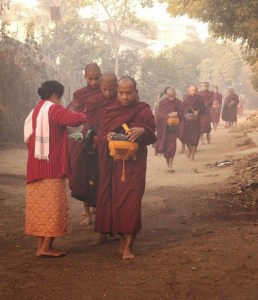
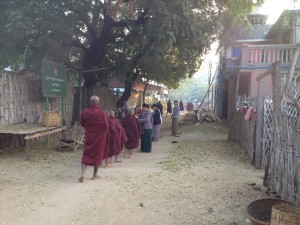
 I think the thing about the trip that has made the deepest…and I hope the most lasting…impression on me was being immersed in the culture of generosity that seems to be at the core of the Burmese way of life.
I think the thing about the trip that has made the deepest…and I hope the most lasting…impression on me was being immersed in the culture of generosity that seems to be at the core of the Burmese way of life.
I mentioned in my first post that one of the highlights was following the monks on their daily alms round. The villagers get up at 4am to make rice to offer to the monks. They are, literally, dirt poor and yet they seem to have such a sense of dignity and self-respect, even joy, when offering their spoonful of rice. And, just as important, the monks display this same sense of dignity and respect. The giving is honored, and so is the receiving. There is no shame or embarrassment or sense of entitlement in the receiving. And no resentment or obligation or guilty sense of having to do one’s duty in the giving. Not even an implied exchange…in the sense of “I’ll do this for you, so you’ll do that for me.” Both sides are participating equally and wholeheartedly in what can only be described as a sacred act.
Our group got to experience that mutual flow of generosity when we stayed at the Shwe Oo Min monastery. Food, lodgings, teachings…everything was offered freely. We all planned to make a donation, of course, but there really was not a sense that this was expected. You could come and stay and eat and sleep–and meditate, or not–and it was all offered without asking for anything back.
But things cost money, of course. So visiting yogis, as well as local supporters, would donate money for the food, or for operating expenses, or whatever. There were no fees. But there was recognition…and great joy…in the receiving.
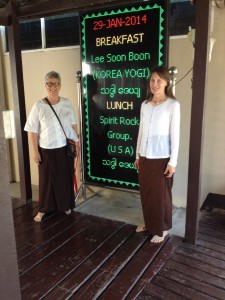
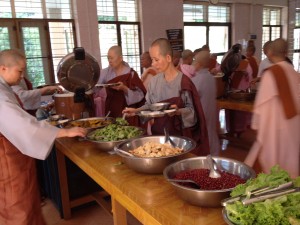
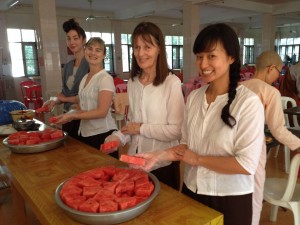
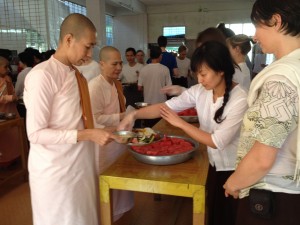 So our group –which had come to be called the Spirit Rock Group by U Tejaniya– decided to pool our planned donation and give it all together as an offering for one of the meals. It cost $200 to feed everyone from breakfast (there were about 200 people in residence at the monastery) and $400 for lunch. The practice of generosity is so pervasive that all the breakfasts in February and all but two of the lunches were already paid for!
So our group –which had come to be called the Spirit Rock Group by U Tejaniya– decided to pool our planned donation and give it all together as an offering for one of the meals. It cost $200 to feed everyone from breakfast (there were about 200 people in residence at the monastery) and $400 for lunch. The practice of generosity is so pervasive that all the breakfasts in February and all but two of the lunches were already paid for!
So we quickly signed up for one of the open lunch days. We thought that that was all we would do…but no, we were told that a gift is something that is done by thought, word and deed. We had done the thought by deciding to make the gift, but we also needed to make a bodily action (the deed) by physically placing the food (or at least, a symbolic portion of it) into the bowl (plate) of those receiving, and in the case of the monks, we needed to recited (silently) a phrase (in Pali), which meant something like “may this offering be a cause and condition for my realization of nibbana.” (Now that’s pretty heavy.)
In my “normal” Wester way of thinking, I would have preferred to give my donation anonymously, or at least quietly and unobtrusively. I would have felt a little uncomfortable giving it with fanfare–the “wealthy” Westerner giving money to the “poor” Burmese monastery. Or I would have felt that it was simply a fee-for-serivce arrangement, no big deal, certainly nothing to celebrate.
But that’s not how the Burmese see it! They put our name up on a 6-foot light board that every one had to pass by as they went into the dining hall. And before that, they had us put the food on the monks table, and the rice directly into their bowls, and then they put us up-front-and-center, so we could publicly place the desert (watermelon) on everyone’s plate.
Everyone was joyous….not to be getting the food, but to be getting to be a part of our act of generosity. And I have to say, it was truly a joy and a pleasure to be able to give in that way!!!
Invisible Kingdoms
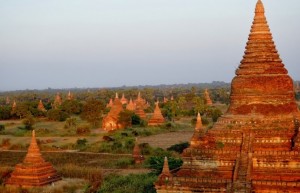
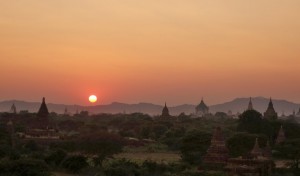 I brought my iPad with me on the trip, expecting mostly to use it for reading material on the plane, but I often turned to it during the trip, in the middle of the day, when it was too hot to be walking around outside. I would read little sections from Invisible Cities, by Italo Calvino, and every day I would get just a few paragraphs into the text and think…OMG, he’s writing about Burma! Here’s a sample:
I brought my iPad with me on the trip, expecting mostly to use it for reading material on the plane, but I often turned to it during the trip, in the middle of the day, when it was too hot to be walking around outside. I would read little sections from Invisible Cities, by Italo Calvino, and every day I would get just a few paragraphs into the text and think…OMG, he’s writing about Burma! Here’s a sample:
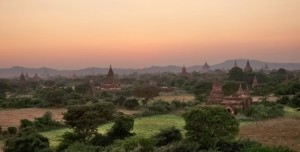 From the high balustrade of the palace the Great Khan watches his empire grow. First the line of the boundaries had expanded to embrace conquered territories, but the regiments’ advance encountered half-deserted regions, scrubby villages of huts, marshes, where the rice refused to sprout, emaciated peoples, dried rivers, reeds.
From the high balustrade of the palace the Great Khan watches his empire grow. First the line of the boundaries had expanded to embrace conquered territories, but the regiments’ advance encountered half-deserted regions, scrubby villages of huts, marshes, where the rice refused to sprout, emaciated peoples, dried rivers, reeds.
“My empire has grown too far toward the outside. It is time,” the Khan thought, “for it to grow within itself,” and he dreamed of pomegranate groves, the fruit so ripe it burst its skin, zebus browning on the spit and dripping fat, veins of metal surfacing in landslips with glistening nuggets.
Now many season of abundance have filled the granaries. The rivers in flood have borne forests of beams to support the bronze roofs of temples and palaces. Caravans of slaves have shifted mountains of serpentine marble across the continent. The Great Khan contemplates an empire covered with cities that weigh upon the earth and upon mankind, crammed with wealth and traffic, overladen with ornaments and offices, complicated with mechanisms and hierarchies, swollen, tense, ponderous.
“The empire is being crushed by its own weight,” Kublai thinks, and in his dreams now cities light as kites appear, pierced cities like laces, cities transparent as mosquito netting, cities like leaves’ veins, cities lined like a hand’s palm, filigree cities to be seen through their opaque and fictitious thickness.
“I shall tell you what I dreamed last night,” he says to Marco. “In the midst of a flat and yellow land, dotted with meteorites and erratic boulders, I saw from a distance the spires of a city rise, slender pinnacles, made in such away that the moon in her journey can rut now on one, now on another, or sway from the cables of the cranes.”
And Polo says, “The city of your dream is Lalage. Its inhabitants arrange these invitations to rest in the night sky so that the moon would grant everything in the city the power to grow ad grow endlessly.”
“There is something you do not know,” the Khan adds. “The grateful moon has granted the city of Lalage a rarer privilege: to grow in lightness.”
***
The photos above are of Bagan, taken from the top of one of the 2,000+ temples and pagodas still remaining from the Kingdom of Pagan, where from the 11th to 13th centuries, more than 10,000 temples were built.
Short and Sweet
For some reason I was having problems posting to Dharma Town earlier today, and now that the issue seems to have resolved itself, I’ve run out of time for a proper post. But no problem. I’ll just leave you with this….one of my favorite photos, taken in Bagan by fellow traveler, Jacob, who by the way is traveling around the word with his wife, Jessica, and who together are keeping a beautiful travel blog, called Radiant Zigzag Becoming, which you can view here.

